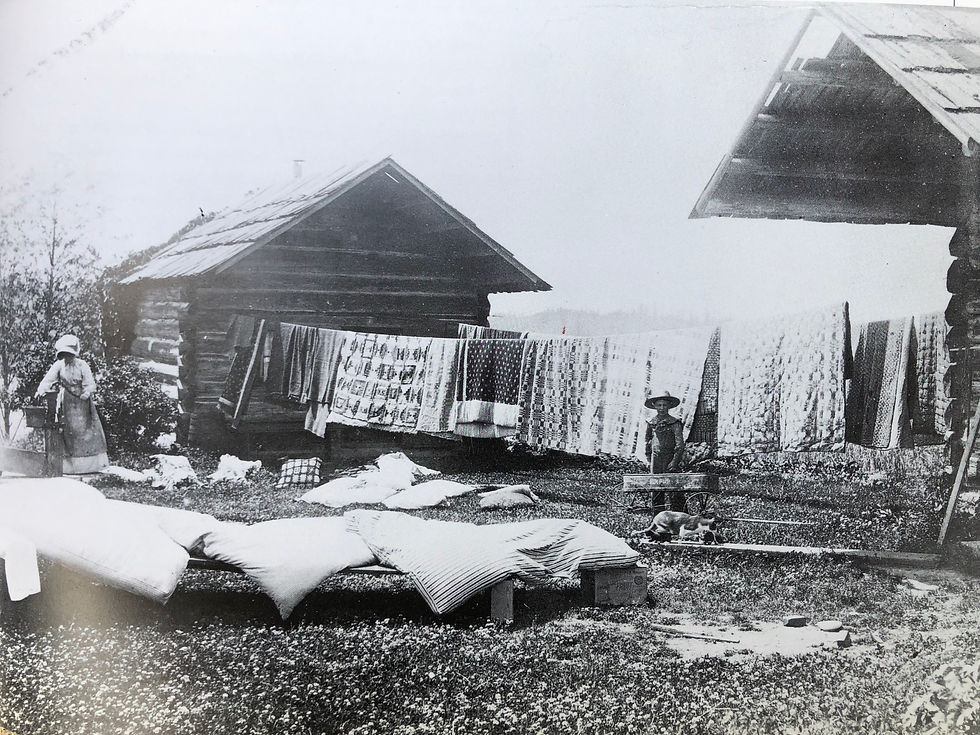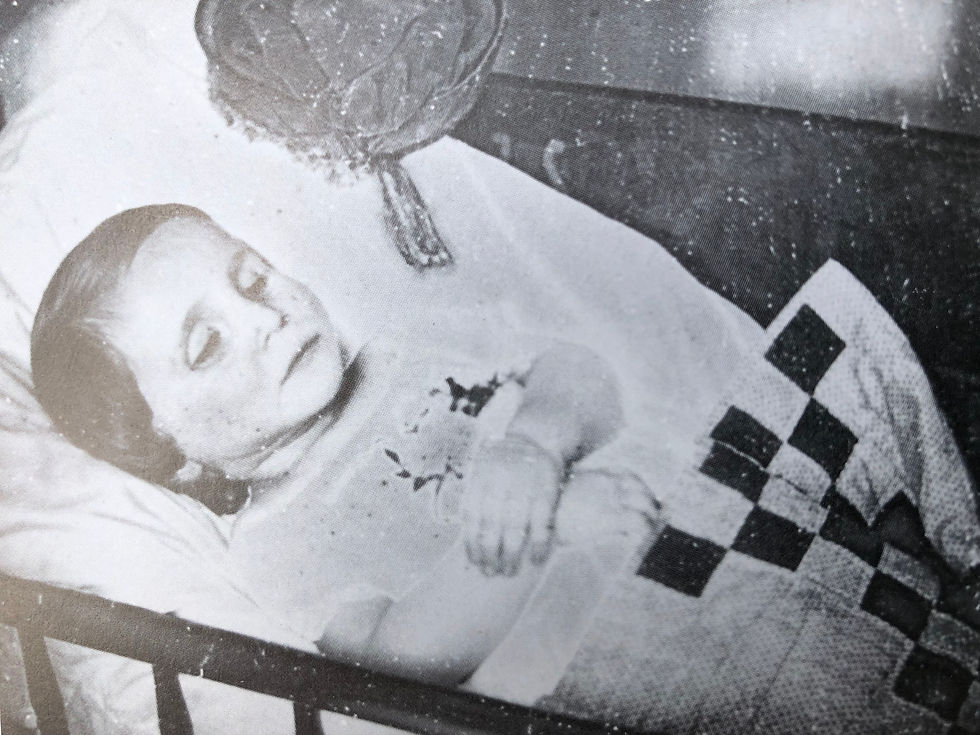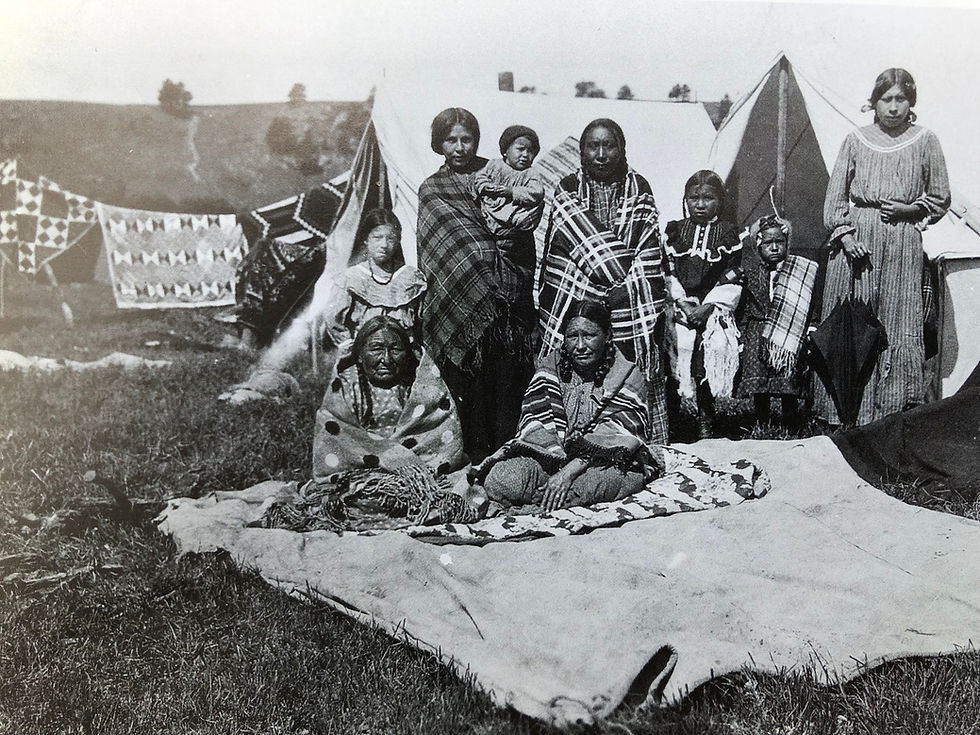Frontier Quilts
- Notes From The Frontier
- Nov 15, 2019
- 8 min read
Updated: May 11, 2023
From home and hearth to revolution
In frontier America, quilts were a way for women to gain immortality. Quilters often called their quilts “diaries” or “albums” because they told stories and were tangible evidence of how a woman had lived her life, cared for her family, built a home, and took pride in her work. Since women were often left out of written history, a quilt was a tangible legacy of her life that would remain on earth for generations after she was dead. A quilt was her book, her needle was her pen.

Quilts not only played a role in personal histories, but in national history, as well. They documented the Civil War on both sides, struggles on the trail west, settling frontier homesteads, as well as the abolition movement, the suffragette movement, and the prohibition movement.
In 1800s America, women and girls of every age, class, racial and ethnic background sewed. Sewing and quilting were synonymous with womanhood and central to the role as woman of the house. And, because time was so precious and work never ended, even socializing among women often took place around quilting bees, so women could sew and socialize at the same time.
Between 1840 and the Civil War, an era of great foment, loss, and movement of Americans to the West, friendship quilts were created in great numbers as commemorations of loved ones lost, of those who left to go West, never to be seen again. Sometimes many women would work on a friendship quilt together for one woman and they would all sign their names on the quilt as a lasting remembrance of their friendship. Westering pioneer women on wagon trains who made friends with fellow travelers often made quilts for each other.

The first 1,000 miles of the main trail West were traveled by both California-bound and Oregon-bound pioneers until they reached a point called “The Parting of the Ways,” just past the Continental Divide at South Pass. Then wagon trains split off going south to California or north to Oregon. Women had a thousand miles to create friendship quilts for dear friends on the trail, since they most likely would never see them again once they’d gone their separate ways. Such quilts often had visual motifs of the journey, such as Winding Way, Wagon Wheel, Wandering Foot, Snail’s Trail, Wild Rose, Indian Trail, Evening Star, Road to California, and Friendship. The Pin Wheel design reflected the power of the constant prairie wind that blew against the cloth-covered wagons.
Some were more freeform and chronicled events they experienced on the trail: births, deaths, passing milestones along the way. Signatures were inked in with dates, place and heartfelt words and sometimes embroidered over the ink.
Willa Cather, the famous Pulitzer Prize winning writer who captured so poignantly life on the frontier in “O Pioneers!” and “My Antonia,” wrote of women quilters on the trail. She called quilts “good bye hugs in cloth” and “broken Hallelujahs” when they swaddled dead children and loved ones for burial on the trail. She added: “People live through such pain only once. Pain comes again—but finds a tougher surface.” Quilts meander through her writing like stitchery:

“The oxen leaned into the yoke, pushing against the wood with their sinewy strength. Under the weight of the covered wagon, the iron rimmed wheels grated against the gravel cutting ruts of legacy. At the beginning of the Oregon Trail, the wooden wagon could take a load of a ton and a half ...A toolbox on one end, water bucket on the other, and a grease bucket in between. Lying on the bottom... heavier supplies like a plow, spinning wheel, stove, bags of seed and a chest of drawers... The top layer displayed the daily necessities: flour and salt, water keg, cooking pot, the Family Bible, a rifle, an ax, and a stack of handstitched, neatly tied, scrappy patchwork quilts.”
One pioneer woman who settled in Texas in the 1830s recalled “quiltin’ bees” where women might try “to out-rival each other in the daintiness of their stitches, but they also helped each other in every way. They helped each other! Perhaps this justifies the whole of a pioneer woman’s suffering.”

Once native Americans were relegated to the reservations and Native children were forced into institutional boarding schools, Native American women began learning white sewing arts and quilting. But they integrated their own cultures into quilt-making and introduced such motifs as Morning Star, Indian Hatchet, Indian Trail, Flying Geese, and other designs inspired by nature and animals. Hopi women began making baby-naming quilts, whereas before white infringement, Hopi men wove the baby blankets.
Since Colonial times, women had created quilts for benevolent societies, the poor, church raffles, and social reform movements. As early as the 1830s abolitionist quilters were making anti-slavery quilts and holding handcraft fairs to raise money for the cause. The first Anti-Slavery Fair was held in Boston in 1834 and was so successful the idea spread throughout New England, then to the Midwest.

Quilts and The Underground Railroad
The abolition movement brought quilting to a heightened art form not only in the anti-slavery narratives white quilt-makers told in their stitches, but in those of black slaves and white abolitionists who sewed secret codes into their coverlets to navigate the Underground Railroad. Certain patterns like the Wagon Wheel, Tumbling Blocks, and Bear Paws, it is believed, contained secret messages that conveyed to slaves means of escape, routes, places of safety. Likewise, white quiltmakers hung certain quilt designs to indicate messages to runaway slaves. A Log Cabin quilt hanging in a window with a black center for the chimney hole was said to indicate a safe house. A variation of Jacob's Ladder gave cues as to the safe path to freedom.
Here is a wonderful video of a quilter demonstrating the quilt blocks used as symbols in quilts during the Underground Railroad:
The Civil War activated women to rally for their respective causes, making quilts for wounded soldiers and hospitals. In the North, the U.S. Sanitary Commission called for quilts for hospitals. (SEE PHOTO #7). Their efforts were so prodigious, more than 300,000 quilts were created; one out of six Union soldiers was kept warm by a hand-sewn quilt!

After the Civil War, alcoholism and drug addiction to morphine and cocaine were at epidemic levels among men, especially those who had been wounded in the war. Alcoholism was raging and ravaged families. Women, especially felt the brunt of alcoholism, as often their only livelihood dissipated in drink and women were left to make ends meet. It became such a serious social problem that women in both the North and the South joined in the temperance movement. And quilts were often a form of expression against “the scourge” and a way to raise money to fight it.
The women’s suffrage movement, also, found its voice in quilts. An irony, too, since quilts had long symbolized domestic femininity but now had taken on more rebellious symbols. The temperance movements and the suffrage movements were closely related in that so many women had found themselves being the sole breadwinners of their families because of male alcoholism and addiction, yet females did not even have the right to vote, own property, or defend themselves against domestic abuse. Thus, the suffrage movement was fueled by the temperance movement. Many a woman turned to her sewing needle to survive and support her family.

Such was the case of Oregon pioneer, Abigail Duniway, who was forced to use her needle to support herself, her invalid husband, and her six young children. She started a millinery business in Portland that, through years of work, became so successful, she was able to sell it, then founded a pro-suffrage weekly newspaper called ”The New Northwest.” In 1869, in the early days of her business, she started a quilt of beautiful reds, yellows, and oranges and had pieced it. But she did not finish it until 30 years later.
She wrote on a block of the finished quilt: “This quilt was pieced in November 1869 by Abigail Scott Duniway of Oregon and was finished and quilted by her in November 1900 and donated to the first National Woman Suffrage Bazaar in honor of Theodore Roosevelt, the first champion of the equal suffrage movement ever elected to a national office by popular vote.” She had planned to donate the quilt to the New York World’s Fair in 1899, but the Portland Woman’s Club raised money to purchase it from her. She donated the funds to the suffrage movement. The quilt now hangs in the Oregon Historical Society.

PHOTOS: (1) One of the oldest known quilts in North Dakota. The photograph was taken at the post office in Pendroy, North Dakota, in 1888, where pioneer women gathered for a quilting bee. The women are quilting an Irish Chain quilt that has patches of calico fabric zigzagging across the page. The Irish Chain design is believed to have started in American in 1814 by Irish immigrant women. Today, the design is quilted in Ireland also but is called “The American Chain Quilt!” (2) Pioneer photographs often display the proud possessions of a family: cattle, pianos, sewing machines, children, AND quilts. Here, multiple generations of quilters in a family in Rutherford County, Tennessee, proudly displaying their quilts in front of their home. Circa 1880s. (3) Pioneer woman airing her many quilts outside her cabin in Green Lake near Seattle, Washington, circa 1900. Special Collections, University of Washington Libraries. (4) A black sharecropping woman shows off her quilt in front of her home with her children. Date & photographer unknown. Slave quilts and quilts of poor women of color are extremely rare, so quilt historians have had to rely on oral traditions and antique quilts that have survived today, handed down through the generations. (5) Native American women learned quilting and adapted it to their own sewing art forms. Here Sioux women on Hot Springs, South Dakota, pose with the quilts. Circa 1900. (6) A rawhide crazy quilt by a Sioux quilter. Circa 1880. This quilt artisan added her own Native American flourishes with beading throughout and embellished with metal jingle cones with horsehair and rawhide fringe around entire quilt. Roger Bounds Foundation photograph. (7) During the Civil War, women in both the North and South responded valiantly to the relief efforts by sewing quilts for soldiers in hospitals. In the North, the U.S. Sanitary Commission called for quilts for hospitals, like this U.S Sanitary Commission Hospital in Washington D.C. Their efforts were so prodigious, one out of six Union soldiers was kept warm by a quilt that a mother, wife, sister or daughter had made. Library of Congress. (8) The death rate was very high in the frontier, especially for babies and children. Often a little one was buried in the family’s most cherished quilt. Death photography became common on the frontier, and the image of the child—swaddled in the quilt—was preserved. Circa 1845, State Historical Society of Wisconsin. LAST 20 IMAGES: A collection of the 20 most popular quilt motifs used in the 1800s and on the frontier. Patterns were usually taken from familiar everyday life. Quilters were not without a sense of humor and gave some of their design names like “Drunkard’s Path,” “Wild Goose Chase,” “Churn Dash,” and “Corn and Beans.”
You may also be interested in these related posts:
-Quilting on the Oregon Trail
-Parting of the Ways
"Frontier Quilts" was first published on Facebook and NotesfromtheFrontier.com on July 31, 19, 2019
584,878 views / 26,943 likes / 16,206 shares / 9,660 photo views / 917 comments
© 2024 NOTES FROM THE FRONTIER



